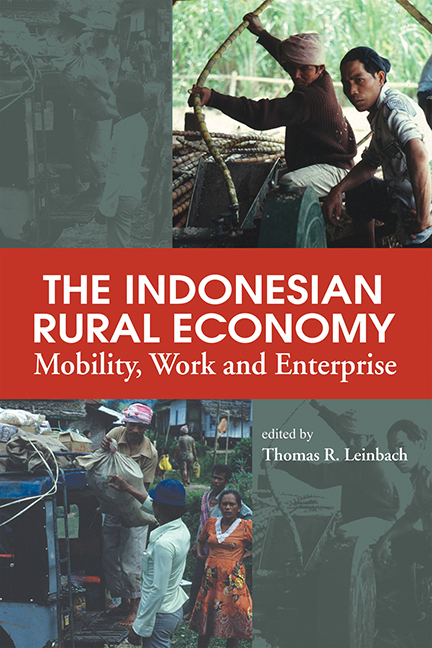Book contents
- Frontmatter
- Content
- List of Tables
- List of Figures
- Contributors
- Acknowledgements
- Glossary
- Foreword
- Part I The Development Context
- Chapter 1 The Indonesian Rural Economy
- Chapter 2 The Changing Importance of Off-Farm Income for Agricultural Households in Indonesia
- Chapter 3 The Economic Policy Environment for Small Rural Enterprises in Indonesia
- Chapter 4 The Contribution of Household and Small Manufacturing Establishments to the Rural Economy
- Part II Entrepreneurship, Gender and Mobility Issues
- Part III Indonesia's Rural Non-Farm Economy: Case Studies and Policy Development
- Index
Chapter 1 - The Indonesian Rural Economy
from Part I - The Development Context
Published online by Cambridge University Press: 21 October 2015
- Frontmatter
- Content
- List of Tables
- List of Figures
- Contributors
- Acknowledgements
- Glossary
- Foreword
- Part I The Development Context
- Chapter 1 The Indonesian Rural Economy
- Chapter 2 The Changing Importance of Off-Farm Income for Agricultural Households in Indonesia
- Chapter 3 The Economic Policy Environment for Small Rural Enterprises in Indonesia
- Chapter 4 The Contribution of Household and Small Manufacturing Establishments to the Rural Economy
- Part II Entrepreneurship, Gender and Mobility Issues
- Part III Indonesia's Rural Non-Farm Economy: Case Studies and Policy Development
- Index
Summary
The last two decades have seen unprecedented change in the economic, political and social fabric of most of Southeast Asia. Traditional patterns of livelihood have been dramatically transformed, and the sum of the influences has gradually had a deep impact over an even longer span of time. While urban centres have been the subject of much attention, the rural areas in Asia are equally critical as we attempt to understand and assess developmental change against the backdrop of the increasingly globalized economy. The transformation of these rural situations continues as a result of the processes of urbanization, industrialization, trade and technological change. While in many ways agriculture remains the heart of development in rural areas, the viability of such places must increasingly be viewed in terms of non-agricultural developments because of the need for increased employment and the impact on and linkages to the broader global economy.
The mutually reinforcing dynamisms of commerce and demography especially have had a tremendous impact on the traditional social fabric of the region—the rural population. Development has in some ways ushered in a cultural crisis where local identities have been lost. There are indeed some arguments suggesting that the end of the peasantry has come to Southeast Asia even though there is an enduring existence of rural production and of the social and economic circuits of life and livelihood which accompany it. “But the rural producers of today are productive and enduring only insofar as they have moved from being peasants into new and different worlds of production, and consequently, of social and economic life. In fact the rural labour force has been radically reconstituted through its own agency and that of the broader forces of change” (Elson 1997, p. 240).
Despite the rapid industrial growth of the last two decades, it is true that Southeast Asia remains a land of farmers. While there is considerable regional variation, nearly 60 percent of the labour force is found in agriculture and roughly 70 percent of the people live in rural areas (Rigg 1997). Yet it is clear that village economies are undergoing dramatic change and can no longer be uniformly characterized as isolated, inward looking and self-sufficient based solely on agriculture. This is especially true of villages situated on the fringes of urban areas. Even for those more remote villages, transport improvements have provided stronger linkages to production and export centres.
- Type
- Chapter
- Information
- The Indonesian Rural EconomyMobility, Work and Enterprise, pp. 3 - 14Publisher: ISEAS–Yusof Ishak InstitutePrint publication year: 2003



